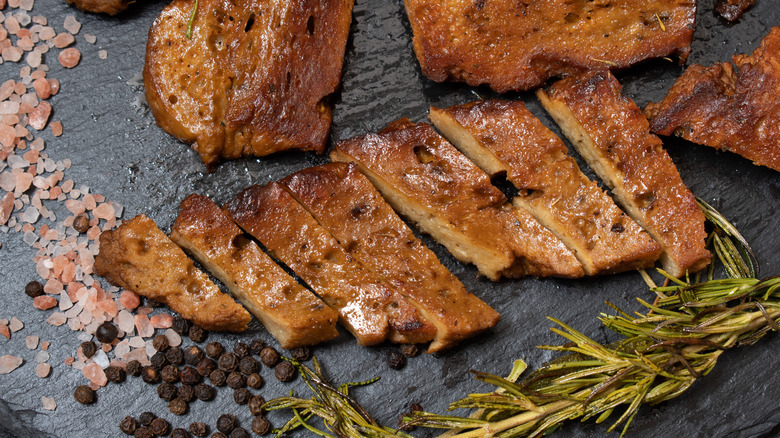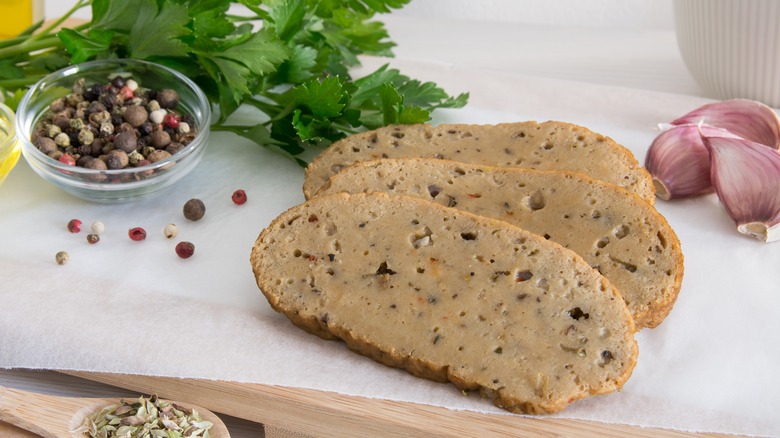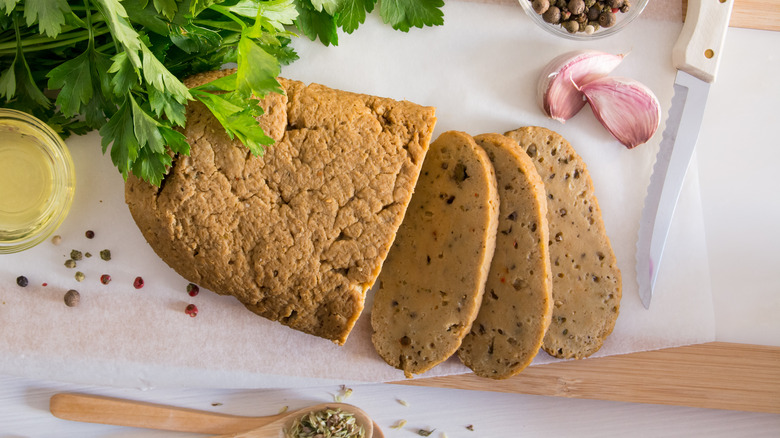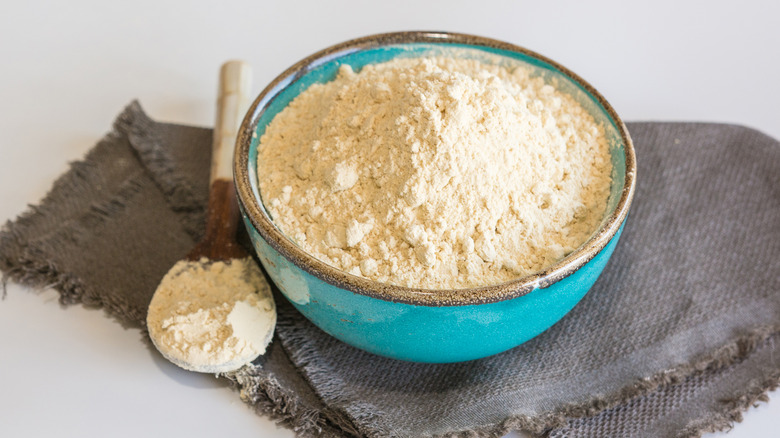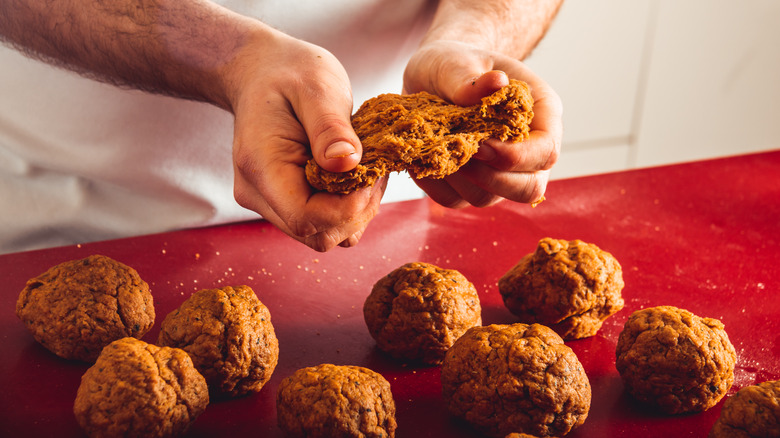What To Keep In Mind Before Using Seitan As A Meat Substitute
Considering there are more options available than ever before, settling on a plant-based meat substitute can be easier said than done. While tofu and tempeh are perfectly reliable protein alternatives, they're not very attractive to those looking for a true meat substitute due to their distinct flavor profiles. However, many store-bought meat alternatives turn out to be less-than-healthy upon closer inspection of the ingredients. If you're a meat-lover-turned-herbivore that is stuck between a rock and a hard place when it comes to flavor and nutrition, it might be time to introduce yourself to a new option: seitan.
Seitan is a gluten-based protein that is part of the growing world of plant-based meats. The primary appeal is how much it tastes like real meat while being 100% plant-based. It's often likened to chicken in terms of flavor and texture, including its ability to soak up flavors from sauces and broth. Because of this convincingly meat-like nature, seitan is an excellent substitute for those who want to lessen their meat consumption, but aren't quite ready to let go of all their favorite meaty recipes.
However, seitan isn't without its drawbacks. The fact that it's entirely based on gluten makes it unsuitable for those with gluten sensitivities or celiac disease. Furthermore, many store-bought varieties come with a prohibitively high sodium content. While seitan might sound like the perfect alternate protein for your tastes, it's important to consider all the facts before using it as your main meat substitute.
Where does seitan come from?
The name "seitan" was coined in the 1960s by George Ohsawa, a Japanese academic and founder of the macrobiotic diet. While this has become the official English loanword for wheat gluten, the food item itself is more widely known as miànjīn in its country of origin, China. Much like tofu, wheat gluten has a long history as an alternative protein that started centuries ago in East Asia. In fact, the earliest known record of it being used as a food item dates back to 535 CE, where a wheat gluten noodle pops up in the world's first agricultural encyclopedia, the "Qimin Yaoshu." By the time the Song dynasty rolled around (circa 960 CE), wheat gluten had already gained its current name of miànjīn and established itself as a widespread meat alternative for practicing Buddhists.
In the modern day, wheat gluten is widely used across East Asia in different forms and with different names. Somewhat ironically, the pre-packaged alt-meat we know as seitan is relatively unknown in Japan itself, where it's enjoyed as a more bread-like snack. By contrast, seitan has broken free from its relative obscurity in the West and is enjoying a recent surge in popularity as the market for alternative options continues to grow.
Breaking down seitan's nutritional composition and potential drawbacks
When looking at the USDA's nutritional breakdown of seitan compared to tofu and tempeh, it's clear that seitan has the highest protein content of the three. With 24.7 grams of protein per 100 gram serving, seitan comes fairly close to the 30.8 grams of protein in 100 grams of beef. Compared to the 17.3 grams and 20.3 grams found in tofu and tempeh respectively, seitan looks to be the most suitable for a one-to-one replacement of meat proteins in your diet. Because it offers almost as much protein without any of the cholesterol that comes with animal flesh, seitan is a solid choice for those who might need to control their cholesterol intake due to health issues like heart disease or type 2 diabetes.
Of course, there are some drawbacks as well. The most obvious disadvantage is that it's completely off the table for anyone with gluten intolerances and celiac disease. Another downside is that, where tofu and tempeh come with a complementary collection of minerals like iron, calcium, potassium, and manganese, seitan only has a small portion of iron and calcium that's dwarfed by the amounts found in the others. Additionally, many brands of store-bought seitan are packaged with high amounts of sodium for both flavor and preservative purposes. Considering the medically recommended daily limit for sodium is 2,300 milligrams for a healthy adult, finding 447 milligrams in just 100 grams of seitan is no joke.
How to make seitan at home
The good news is that the incredibly high amount of sodium found in store-bought seitan isn't inherent to seitan itself. You can either shop around for brands that don't pack as much, or simply make it at home to your own tastes and nutritional needs.
Because seitan is so versatile, there are a number of different ways to make it that change its taste and texture. First, you'll need to grab some vital wheat gluten and decide on what flavors you want to incorporate into your seitan. Most recipes will start with vegetable broth powder or vegetable bouillon cubes as a base for the savory taste, then add umami through ingredients like soy sauce or garlic salt.
The basic process of making seitan is strikingly like baking bread: You sift together all the dry ingredients, then incorporate the wet ingredients until you have a dough. The wet-dry ratio of this dough as well as how you cook it will decide the texture of the final product, and you have a ton of different options. You can either boil, steam, bake, or saute the dough to get a variety of textures and consistencies, ranging from softer, more tender forms to firmer, chewier variations. Additionally, you can choose any shape to cook the seitan into, whether it's a thick loaf to be cut into slices, bite-sized bits torn off by hand, or any other configuration that best suits whatever recipe you plan to cook with it.
Best ways to use seitan in your cooking
When it comes to cooking, seitan's neutral taste and absorbent nature make it an ideal base for soaking up a myriad of flavors. This adaptability makes it shine as a meat substitute in an incredible variety of dishes. You can practically make a vegan version of nearly any recipe by including seitan in the right shape and consistency. Slice or dice seitan and stir-fry it with your favorite vegetables and sauces, or marinate it and throw it on the grill for a delicious and smoky flavor. You can use it in kebabs, burgers, or BBQ sandwiches for a plant-based twist on classic grilled dishes.
Seitan can also hold its own when thrown into broth, both soaking up the flavors and retaining its chewy texture in hearty comfort dishes like beef stews, casseroles, and various soups and curries. You can chop it up into thin strips and use it as filling for pitas, fajitas, and quesadillas, not to mention pizza or flatbread topping. Despite its drawbacks, seitan truly knocks it out of the park when it comes to versatility — don't be afraid to experiment with different marinades, spices, and cooking methods to discover your favorite way to enjoy this adaptable alternative to meat.
